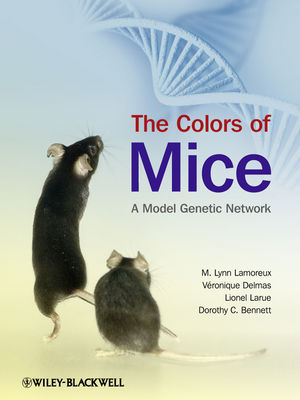The Colors of Mice: A Model Genetic NetworkISBN: 978-1-4051-7954-6
Hardcover
312 pages
May 2010, Wiley-Blackwell
 |
||||||
Acknowledgments.
Statement regarding the use of pictures.
Statement regarding nomenclature.
Part I: Introduction to the Pigmentary System.
1. Introduction to the Pigmentary System.
1.1. Introduction.
1.2. Colors of vertebrate animals.
1.3. Other pigment cells.
1.4. The epidermal melanin unit.
1.5. Mammalian hair.
1.6. Melanosome biogenesis and translocation.
1.7. Melanin.
1.8. Hair growth.
1.9. Hair growth cycles.
1.10. Embryonic development of the pigment cell lineage.
1.11. Pigment cells in culture.
1.12. Conclusion.
Appendix: color loci of the mouse.
Part II: The Pigmentary Loci.
2. Introduction to Mutant Pigmentary Genes.
2.1. Defects of normal melanocyte development: white spotting and graying with age.
2.2. Defects in normal melanosome development: albinism.
2.3. Transport of melanosomes to other cells: the ‘dilute’ phenotype.
2.4. Pigment-type switching: from eumelanogenesis to pheomelanogenesis.
3. White Spotting and Progressive Graying.
3.1. Definitions and general background .
3.2. Pigment cell development: developmental biology.
3.3. Cellular signaling pathways for melanocytes.
3.4. Pigment phenotypes and the classical white-spotting genes.
3.5. The head, heart, ears, and eyes.
4. ’Albinism’ and the Failure of Normal Melanosome Development.
4.1. Background.
4.2. The melanosomal matrix.
4.3. The enzymes that catalyze melanogenesis.
4.4. Membrane proteins that regulate the internal milieu of the melanosome.
4.5. Protein processing and routing to the maturing melanosome.
4.6. Melanosome transport.
5. Pigment-Type Switching.
5.1. Introduction.
5.2. Yellow phenotypes.
5.3. Melanin pigment .
5.4. Melanogenesis and the eumelanin/pheomelanin switch mechanism.
5.5. Signaling the switch mechanism at the cellular level.
5.6. Yellow genes.
Part III: Technology and Resources.
6. Novel Mouse Pigmentary Mutants Generated by Genetic Manipulation.
6.1. Introduction.
6.2. Mouse transgenesis: generation of genetically engineered mice.
6.3. Coat-color transgenic mice.
6.4. The coat-color mutants generated by gene targeting.
6.5. Influence of the genetic background.
6.6. Conclusions.
7. Other Species and Other Resources.
7.1. Introduction.
7.2. Resources.
7.3. Other species.
References.
Index.



